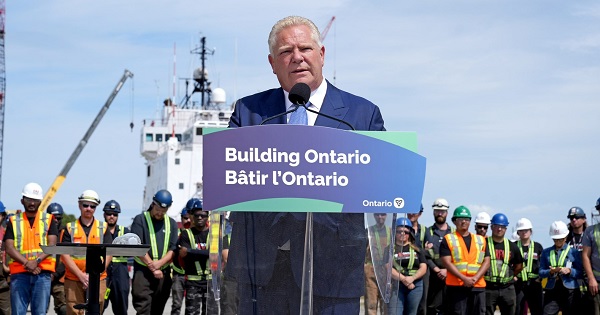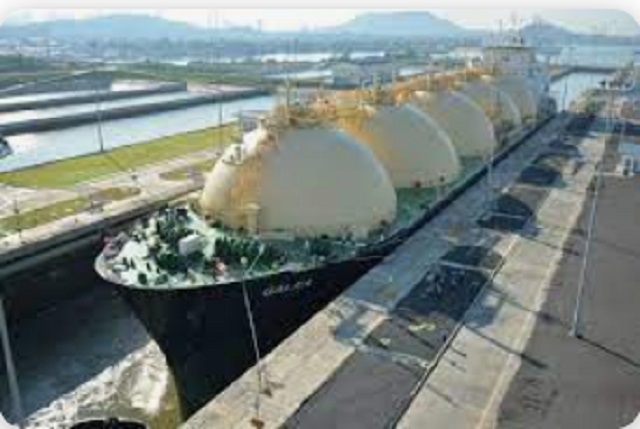Economy
Doug Ford – the Net Zero Premier

 By Dan McTeague
By Dan McTeague
Doug Ford came into power promising a change from the Kathleen Wynne Green Energy Act fiasco – the one which saddled Ontario taxpayers with costly green energy contracts, driving up the price of power. Ford promised to scrap those wasteful contracts, lower hydro rates, and restore affordability to Ontario. But as we take stock of his energy policies today, it seems Ford is steering Ontario down a path that feels a bit too familiar.
For all his talk about energy affordability, Ford continues to pander to the environmentalist “Net Zero” ideology that got Ontario into this mess in the first place. The idea is that somehow Canada will be a net zero emitter of greenhouse gas emissions by 2050. We have seen this play out at the Federal level, with the Trudeau Liberals implementing a host of reckless and punitive policies in the vain hopes of achieving this preposterous goal. You can thank Net Zero for Carbon Taxes, Emissions Caps, the Clean Fuel Standard, Electric Vehicle Mandates and on and on.
Instead of backing away and distancing himself from this scam, Doug Ford has embraced and doubled down on it. Recall that during a provincial leaders debate in June 2022, Ford stated that he will not be happy until Ontario achieves a 100% zero-carbon electricity grid, buying into the Net Zero electrification nonsense that the Trudeau government is pushing. This would mean moving away from fossil fuels like affordable and reliable natural gas as energy sources in Ontario.
Stephen Lecce, Ford’s minister of the recently renamed Ministry of Energy and Electrification, is full steam ahead on this project. And the ministry’s new name is significant, pointing towards an “energy transition” for Ontario, such that eventually everything – cars, home heating, etc. – will be run on electricity rather than traditional fuels.
Currently, about 20 per cent of Ontario’s energy needs are met by electricity, so where will this electricity come from, without fossil fuels? At a recent Empire Club event, Ford gave a fireside chat where he discussed Ontario’s electricity plan (you can hear the interview here). He spoke about the energy sector and his commitment to all low carbon options for Ontario’s electricity grid, including wind and solar. This marks a reversal of his earlier skepticism about these technologies. The irony is that Ontario taxpayers are still paying for the expensive legacy of earlier wind and solar government spending. Wasting more taxpayer dollars will mean more of the following: higher energy costs, decreased grid reliability, and growing public debt.
As energy expert Parker Gallant has pointed out, the costs of wind power alone have been staggering, with taxpayers footing the bill for inefficient projects that deliver intermittent power. Doubling down on these same strategies, even under a different name, does little to address affordability or reliability.
Ford has hitched his horse fully to the Net Zero wagon. According to his government’s policy document Planning for electrification and the energy transition: “Much of the world – including many of Ontario’s major trading partners – have committed to achieving economy-wide carbon neutrality by 2050.” Consequently, it recommends that Ontario adopt similar Net Zero strategies, as doing so allegedly contributes “to the global climate solution and thereby sets the province up to succeed and prosper in the emerging global clean energy economy.”
These claims didn’t make sense when they were made five years ago and they make even less sense today. Afterall, Ontario’s largest trading partner to the South has just elected Donald Trump whose policy approach to energy can be summarized by the phrase, “Drill Baby Drill.” We can expect that one of Trump’s first acts as president will be to (once again) exit the Paris Agreement. Trump has no intention of drinking the Net Zero KoolAid, though he will no doubt be happy to have America’s competitors like Canada burden themselves with unnecessary environmental commitments and regulations, which will drive up the cost of doing business and make “made in America” a much more attractive brand. Competitiveness and affordability in Canada can go out the window as manufacturers and businesses will start looking South as the more attractive business environment.
While Trump seeks to unleash the United States’ energy potential, Ford will only stifle Ontario’s. Which is to say, Ford is setting Ontario up for failure. Now that is a real net zero.
Dan McTeague is President of Canadians for Affordable Energy.
Business
Canada Can Finally Profit From LNG If Ottawa Stops Dragging Its Feet

From the Frontier Centre for Public Policy
By Ian Madsen
Canada’s growing LNG exports are opening global markets and reducing dependence on U.S. prices, if Ottawa allows the pipelines and export facilities needed to reach those markets
Canada’s LNG advantage is clear, but federal bottlenecks still risk turning a rare opening into another missed opportunity
Canada is finally in a position to profit from global LNG demand. But that opportunity will slip away unless Ottawa supports the pipelines and export capacity needed to reach those markets.
Most major LNG and pipeline projects still need federal impact assessments and approvals, which means Ottawa can delay or block them even when provincial and Indigenous governments are onside. Several major projects are already moving ahead, which makes Ottawa’s role even more important.
The Ksi Lisims floating liquefaction and export facility near Prince Rupert, British Columbia, along with the LNG Canada terminal at Kitimat, B.C., Cedar LNG and a likely expansion of LNG Canada, are all increasing Canada’s export capacity. For the first time, Canada will be able to sell natural gas to overseas buyers instead of relying solely on the U.S. market and its lower prices.
These projects give the northeast B.C. and northwest Alberta Montney region a long-needed outlet for its natural gas. Horizontal drilling and hydraulic fracturing made it possible to tap these reserves at scale. Until 2025, producers had no choice but to sell into the saturated U.S. market at whatever price American buyers offered. Gaining access to world markets marks one of the most significant changes for an industry long tied to U.S. pricing.
According to an International Gas Union report, “Global liquefied natural gas (LNG) trade grew by 2.4 per cent in 2024 to 411.24 million tonnes, connecting 22 exporting markets with 48 importing markets.” LNG still represents a small share of global natural gas production, but it opens the door to buyers willing to pay more than U.S. markets.
LNG Canada is expected to export a meaningful share of Canada’s natural gas when fully operational. Statistics Canada reports that Canada already contributes to global LNG exports, and that contribution is poised to rise as new facilities come online.
Higher returns have encouraged more development in the Montney region, which produces more than half of Canada’s natural gas. A growing share now goes directly to LNG Canada.
Canadian LNG projects have lower estimated break-even costs than several U.S. or Mexican facilities. That gives Canada a cost advantage in Asia, where LNG demand continues to grow.
Asian LNG prices are higher because major buyers such as Japan and South Korea lack domestic natural gas and rely heavily on imports tied to global price benchmarks. In June 2025, LNG in East Asia sold well above Canadian break-even levels. This price difference, combined with Canada’s competitive costs, gives exporters strong margins compared with sales into North American markets.
The International Energy Agency expects global LNG exports to rise significantly by 2030 as Europe replaces Russian pipeline gas and Asian economies increase their LNG use. Canada is entering the global market at the right time, which strengthens the case for expanding LNG capacity.
As Canadian and U.S. LNG exports grow, North American supply will tighten and local prices will rise. Higher domestic prices will raise revenues and shrink the discount that drains billions from Canada’s economy.
Canada loses more than $20 billion a year because of an estimated $20-per-barrel discount on oil and about $2 per gigajoule on natural gas, according to the Frontier Centre for Public Policy’s energy discount tracker. Those losses appear directly in public budgets. Higher natural gas revenues help fund provincial services, health care, infrastructure and Indigenous revenue-sharing agreements that rely on resource income.
Canada is already seeing early gains from selling more natural gas into global markets. Government support for more pipelines and LNG export capacity would build on those gains and lift GDP and incomes. Ottawa’s job is straightforward. Let the industry reach the markets willing to pay.
Ian Madsen is a senior policy analyst at the Frontier Centre for Public Policy.
Economy
Affordable housing out of reach everywhere in Canada

From the Fraser Institute
By Steven Globerman, Joel Emes and Austin Thompson
According to our new study, in 2023 (the latest year of comparable data), typical homes on the market were unaffordable for families earning the local median income in every major Canadian city
The dream of homeownership is alive, but not well. Nearly nine in ten young Canadians (aged 18-29) aspire to own a home—but share a similar worry about the current state of housing in Canada.
Of course, those worries are justified. According to our new study, in 2023 (the latest year of comparable data), typical homes on the market were unaffordable for families earning the local median income in every major Canadian city. It’s not just Vancouver and Toronto—housing affordability has eroded nationwide.
Aspiring homeowners face two distinct challenges—saving enough for a downpayment and keeping up with mortgage payments. Both have become harder in recent years.
For example, in 2014, across 36 of Canada’s largest cities, a 20 per cent downpayment for a typical home—detached house, townhouse, condo—cost the equivalent of 14.1 months (on average) of after-tax income for families earning the median income. By 2023, that figure had grown to 22.0 months—a 56 per cent increase. During the same period for those same families, a mortgage payment for a typical home increased (as a share of after-tax incomes) from 29.9 per cent to 56.6 per cent.
No major city has been spared. Between 2014 and 2023, the price of a typical home rose faster than the growth of median after-tax family income in 32 out of 36 of Canada’s largest cities. And in all 36 cities, the monthly mortgage payment on a typical home grew (again, as a share of median after-tax family income), reflecting rising house prices and higher mortgage rates.
While the housing affordability crisis is national in scope, the challenge differs between cities.
In 2023, a median-income-earning family in Fredericton, the most affordable large city for homeownership in Canada, had save the equivalent of 10.6 months of after-tax income ($56,240) for a 20 per cent downpayment on a typical home—and the monthly mortgage payment ($1,445) required 27.2 per cent of that family’s after-tax income. Meanwhile, a median-income-earning family in Vancouver, Canada’s least affordable city, had to spend the equivalent of 43.7 months of after-tax income ($235,520) for a 20 per cent downpayment on a typical home with a monthly mortgage ($6,052) that required 112.3 per cent of its after-tax income—a financial impossibility unless the family could rely on support from family or friends.
The financial barriers to homeownership are clearly greater in Vancouver. But, crucially, neither city is truly “affordable.” In Fredericton and Vancouver, as in every other major Canadian city, buying a typical home with the median income produces a debt burden beyond what’s advisable. Recent house price declines in cities such as Vancouver and Toronto have provided some relief, but homeownership remains far beyond the reach of many families—and a sharp slowdown in homebuilding threatens to limit further gains in affordability.
For families priced out of homeownership, renting doesn’t offer much relief, as rent affordability has also declined in nearly every city. In 2014, rental rates for the median-priced rental unit required 19.8 per cent of median after-tax family income, on average across major cities. By 2023, that figure had risen to 23.5 per cent. And in the least affordable cities for renters, Toronto and Vancouver, a median-priced rental required more than 30 per cent of median after-tax family income. That’s a heavy burden for Canada’s renters who typically earn less than homeowners. It’s also an added financial barrier to homeownership— many Canadian families rent for years before buying their first home, and higher rents make it harder to save for a downpayment.
In light of these realities, Canadians should ask—why have house prices and rental rates outpaced income growth?
Poor public policy has played a key role. Local regulations, lengthy municipal approval processes, and costly taxes and fees all combine to hinder housing development. And the federal government allowed a historic surge in immigration that greatly outpaced new home construction. It’s simple supply and demand—when more people chase a limited (and restricted) supply of homes, prices rise. Meanwhile, after-tax incomes aren’t keeping pace, as government policies that discourage investment and economic growth also discourage wage growth.
Canadians still want to own homes, but a decade of deteriorating affordability has made that a distant prospect for many families. Reversing the trend will require accelerated homebuilding, better-paced immigration and policies that grow wages while limiting tax bills for Canadians—changes governments routinely promise but rarely deliver.
-

 espionage1 day ago
espionage1 day agoWestern Campuses Help Build China’s Digital Dragnet With U.S. Tax Funds, Study Warns
-

 Bruce Dowbiggin1 day ago
Bruce Dowbiggin1 day agoWayne Gretzky’s Terrible, Awful Week.. And Soccer/ Football.
-

 Opinion2 days ago
Opinion2 days agoThe day the ‘King of rock ‘n’ roll saved the Arizona memorial
-

 Focal Points2 days ago
Focal Points2 days agoCommon Vaccines Linked to 38-50% Increased Risk of Dementia and Alzheimer’s
-

 Health1 day ago
Health1 day agoCDC Vaccine Panel Votes to End Universal Hep B Vaccine for Newborns
-

 Business1 day ago
Business1 day agoCanada invests $34 million in Chinese drones now considered to be ‘high security risks’
-

 Agriculture1 day ago
Agriculture1 day agoCanada’s air quality among the best in the world
-

 Business1 day ago
Business1 day agoThe EU Insists Its X Fine Isn’t About Censorship. Here’s Why It Is.













